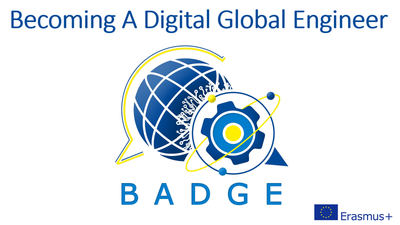BADGE – Becoming a Digital Global Engineer

Intellectual Output
BADGE – Becoming a Digital Global Engineer
Project 2019-1-FR01-KA203-063010 (167 512 512)

BADGE – Becoming a Digital Global Engineer
Project 2019-1-FR01-KA203-063010 (167 512 512)

After studying this lesson on writing a resume, you will be able to

What’s the difference between a resume and a CV (Curriculum Vitae)?
What should you include in a resume?
How long should a resume be?
With, on average, 200+ resumes received in the UK for every job advertised, employers do not have much time to devote their attention to each one. According to research, employers spend between 5 to 7 seconds on each resume. In addition, certain aspects may not even get you that amount of time – any spelling / grammar mistakes will almost certainly see your resume land immediately in the bin, and there is a roughly 75% chance that your resume will be discarded if an unprofessional email address is used. Even attaching a photo to your resume might be a risk as many employers prefer documents they can view objectively. However, it is worth checking the requirements of the company you’re applying to or the country conventions with regard to this. All in all, with such a short amount of time to make an impression and with such competition, an applicant has to make sure that their resume stands out and warrants closer attention.
https://www.retailappointment.co.uk/career-advice/talking-shop/job-seeking-by-numbers
Most employers expect job applicants to provide a CV (Curriculum Vitae) or a resume. In many countries, these terms are used interchangeably, but in others there may be a difference between them. For example, in the US, a resume is used when applying for regular jobs, while a CV is for academic positions. In any case, a CV or a resume is a document which gives an overview of a candidate’s qualifications, skills and work experience, so that employers can select the most suitable applicants to invite for an interview. For this reason, it is important to spend time compiling a CV or resume which best depicts you, your background and what you can offer a future employer.
A resume (the term used from now on) is, in most cases, the first contact you have with a prospective employer, therefore you need to consider what impression your resume will make. For a favourable first impression, you need to take into account not only what information you should include, but also how much of that information is relevant to the particular position you are applying for, as well as how the information should be presented. However, bear in mind that your resume should be no more than 2 pages of A4 – any longer and it will go unread.
There is no set structure or content for a resume, but some information is essential, such as your name and contact details, for obvious reasons. The headings for each section should reflect the content, but do not necessarily need to be the same as shown below.
Depending on whether you are a student applying for your first job, or an experienced engineer, the sections of your resume may vary and appear in a different order. At any rate, your best and most relevant features should probably appear near the top of your resume. Additional sections may include a personal profile as well as information on your achievements, memberships of professional associations and interests. However, your resume should be tailored to the job you apply for and may not include the same information each time.
In terms of format, it is best to use the same standard font throughout and avoid cluttering your resume with too many lines, boxes and tables. A ‘clean’, easy-to-read resume is what you should aim for, especially as the person who reads it may only do so for a matter of seconds and needs to be able to see the most important information at a glance. With that in mind, sentences should be relatively short, and it is common to use bullet-points to list skills, work responsibilities, achievements, etc. When outlining your qualifications, work experience, training and industrial placements, it is usual to omit the pronoun ‘I’ and use the verb in the present simple for a job you are currently doing, eg. ‘Provide product support to clients’, ‘Execute equipment maintenance strategies’, or past simple form for past work experience, eg. ‘Examined installations to ensure conformance to design specifications’, ‘Attended 6-week course in Leadership Skills’, ‘Supervised and lead a team of 15.’ Finally, remember to write the most recent qualifications and work experience first, and then work backwards.
Below is an example of the resume of a recent engineering graduate. Notice the personal profile which appears near the beginning, just after the candidate’s name and contact details, which acts as an introduction to the resume. A personal profile, known also as a personal statement or summary, is optional but is becoming increasingly common. So, why write a personal profile? This is the section in which you can emphasise what makes you attractive as an applicant. It tends to be no more than a few sentences in length, and it focuses on your personal qualities, your relevant skills, what you are looking for from a particular post and what you hope to achieve. The personal profile is very often written in the third person, but without using the ‘he/she’ pronoun, eg. Ambitious, pro-active environmental engineering graduate with excellent communication skills seeks position with an innovative, forward-thinking company to build on knowledge and skills.
|
Samuel Wilton samuel.wilton@email.com Tel: 02980 324576 28 Basil Rd, Cambridge, CM8 4TY
Personal profile Enthusiastic, results-oriented Production Engineer with strong problem-solving and critical-thinking skills seeks an entry level position in an established organisation with a view to developing the necessary skills to lead process improvement activities.
Education Sept 2019 – Aug 2020: MSc Advanced Manufacturing, University of Strathclyde Glasgow Oct 2015 – June 2019: BEng Manufacturing Engineering, Loughborough University
Industrial training / work placements
- assisted production manager with process development - developed alternative ways to reach manufacturing goals - recommended new equipment to increase production - created quarterly manufacturing process report for management
- carried out quality checks of manufacturing process and assisted production manager in ensuring optimum usage of workers and machinery - identified issues on assembly line - devised and implemented plan to automate steps in production process to reduce repetitive tasks of assembly line operators and thus ensure efficiency
Employment history
- gained experience in using Solidworks 3D CAD software - worked alongside engineers of all levels within the company and gained valuable practical experience in implementing and monitoring production processes - provided input for technical reports
- assembled wooden products - carried out quality control checks of materials and finished products - learned new skills related to joinery and carpentry - gained experience using hand tools - exceeded daily targets on a regular basis
- lead a team of 8 operatives in the packing and dispatch of orders - liaised with management to introduce new packing procedures - monitored and streamlined packing - operated forklift and power pallet
Skills Computer Skills: Pro/Engineer, Pro/Manufacturing, Microsoft Word/Excel/PowerPoint Equipment: Milling, CNC lathing, rapid prototyping, basic welding & casting Language Skills: Fluent French, Upper-intermediate level Italian.
Interests
References available upon request |
|
Dummett, P. (n.d.). Advanced Business Writing Worksheets. Worksheet 1: A CV or resume. Retrieved 14.05.21 from https://www.ngllife.com/content/business-writing-worksheets
https://novoresume.com/career-blog/engineering-resume retrieved 14.05.21
https://www.retailappointment.co.uk/career-advice/talking-shop/job-seeking-by-numbers retrieved 17.05.21
https://www.thescholarshiphub.org.uk/how-write-good-cv-guide-students/ retrieved 17.05.21
https://worksheets.theteacherscorner.net/make-your-own/crossword/ retrieved 14.06.21
https://dictionary.cambridge.org/ retrieved 14.06.21